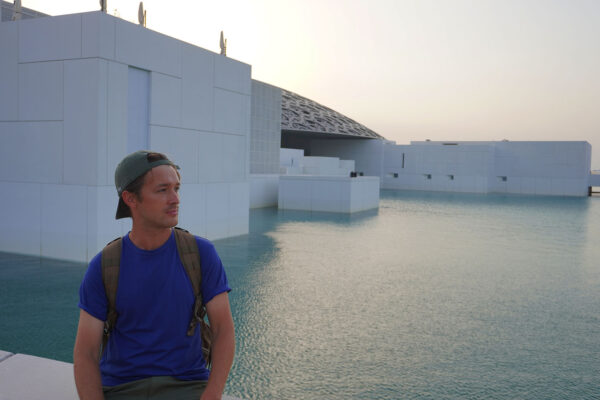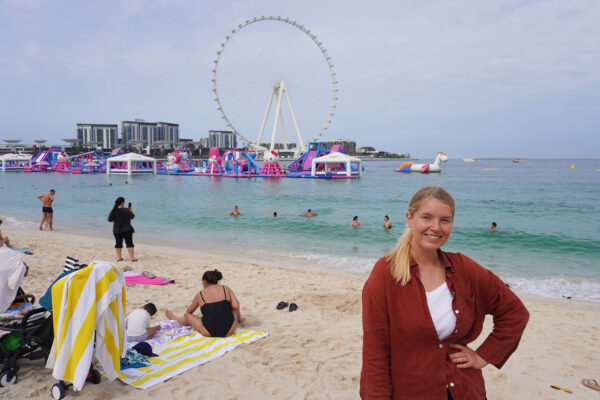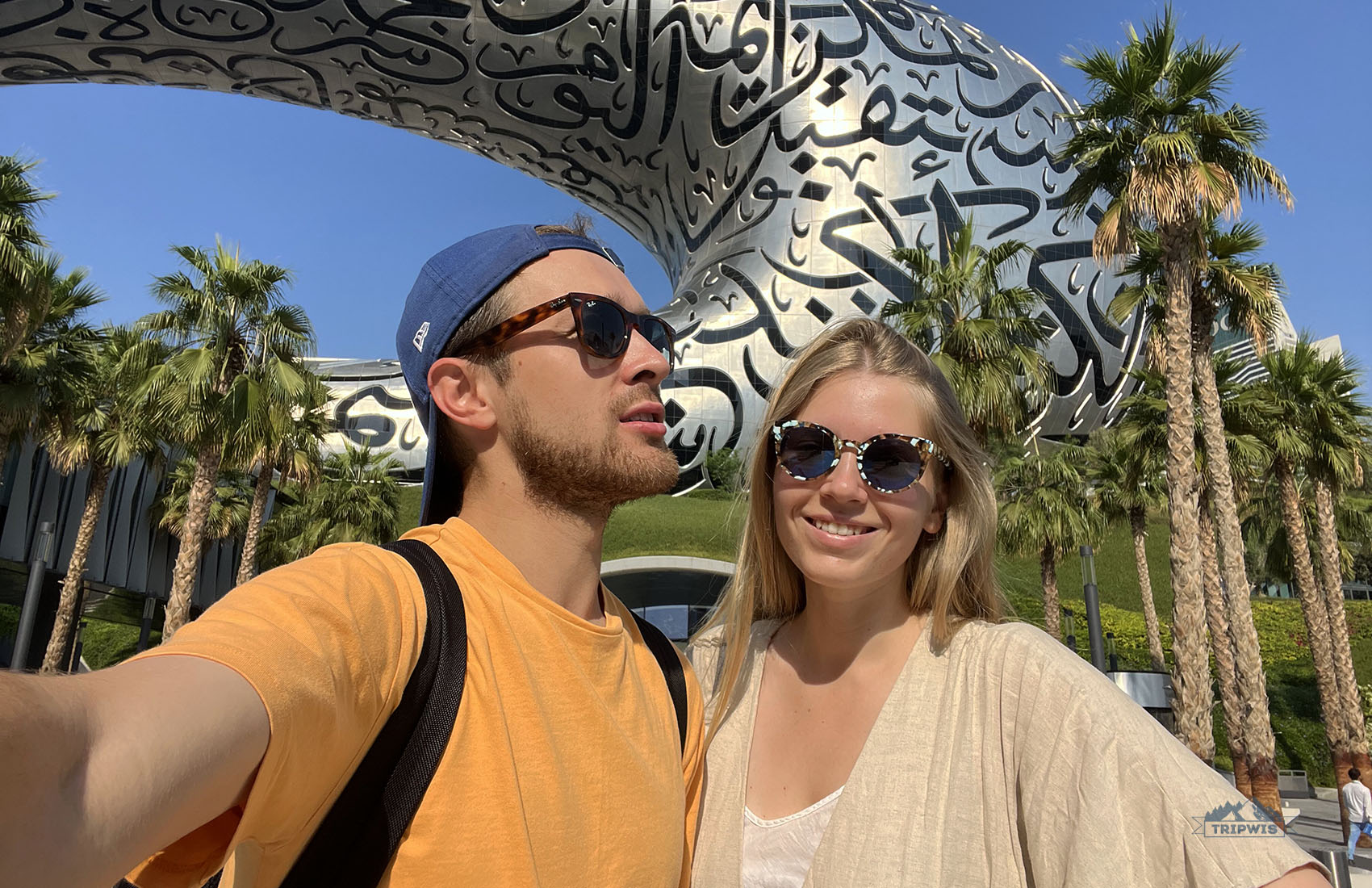
Let’s be clear on one thing: It’s common knowledge now that Dubai and the UAE in general have become a so-called playground for the ultra-wealthy.
We made it our journey to come and see the place not only from a touristic standpoint, but also as people mesmerized by how the society here uses its earnings and what city establishments the money is funneling into.
Museum of the Future in Dubai is one of such places where the United Arab Emirates finance all the wonderful breakthroughs happening at the forefront of science. Even the building itself is an architectural marvel that made the museum a prominent part of Dubai’s skyline.
We had so much fun during our visit, and we cannot wait to share our thoughts (as well as useful tips) with all of you!
Article contents
- What is so special about the Museum of the Future in Dubai?
- What are the exhibitions in the Museum?
- Things to do nearby
- Important information
- Which museums in Dubai and Abu Dhabi do we recommend?
What is so special about the Museum of the Future in Dubai?

Even if you have never been to Dubai, you still have probably seen photos of the Museum of the Future online. And for good reason, since National Geographic deemed it as one of the most beautiful museums in the world in 2021! Since its opening on 22 February 2022 (a palindrome date, meaning that it reads the same from either end — 2/22/22), it’s gained even more traction and recognition for both its eccentric exterior and unique exhibitions.
The first impression is the most important one: And we think that the building of the museum can floor even the most seasoned art critic with its shape and detailing. It’s fascinating to learn that the architect — Shaun Killa — together with his team used AI to help render the building’s structural prototypes and to map out the calligraphy on the 1024 panels that adorn the exterior so that everything went together and didn’t collapse.
We feel the urge to put the writings on the walls in full here, as these words by His Highness Sheikh Mohammed Bin Rashid Al Maktoum tell you everything you need to know about the museum’s mission:
- “We won’t live for hundreds of years, but we can create something that will last for hundreds of years.”
- “The future will be for those who will be able to imagine, design and build it, the future does not wait, the future can be designed and built today.”
- “The secret of the renewal of life, the development of civilization and the progress of humanity is in one word: innovation.”
Let’s give it up one more time for the museum’s unique shape. Some compare it to the eye that looks into the future of Dubai, others call it the egg that rolled on a hill by the road and stayed there. The original idea is that the circular shape represents humanity, the green hill the building stands on represents the Earth, and the opening in the middle — the void, where nothing can be known for sure, leaving plenty of room for imagination.
Pro tip: To get the best photos with the Museum of the Future, enter its inner courtyard and angle your camera slightly upwards — you’ll thank us later!
Tickets to Museum of the Future >>
We can go on and on about the design and remarkable architectural decisions (the building has zero corners and zero supporting columns, for crying out loud!) but what the Museum of the Future wins at is its spectacular exhibitions.
So, after witnessing Dubai’s present by looking at the city from the viewing deck of the world-famous Burj Khalifa, it’s time to look into the emirate’s (and the whole world’s) future. Keep reading to learn what you should be prepping for as you plan your visit to the Museum of the Future in Dubai!
Is Dubai Museum of the Future worth it?

In our opinion, Museum of the Future should be at the top of the list of things to explore while in the Emirates, even if you only have 1 day in Dubai. The exhibitions in the Museum of the Future in Dubai are the things that not only teach you about the importance of community as we move forward into the future, but also inspire young minds to become pro-active about their lives here, on Earth.
A couple of things that we found not entirely thought through that can cause discomfort for people going inside the Museum of the Future in Dubai were:
- English was the only language used by the staff, as well as the only language of informational stands (aside from some signs). If you have trouble understanding English, you’ll be pretty clueless about what is going on inside the exhibitions. Don’t get us wrong, it’s still a fun experience regardless, but not as complete as it could be! Take it from Louvre Abu Dhabi: All the info there is given in Arabic, English, and French.
- Some areas (like the OSS Hope Station, which we will talk about in more detail further down in the article) can be too dimly lit for some people to easily make out the writing on the stands.
Aside from that, trust us, you will not regret visiting the Museum of the Future: It’s the experience unlike anything we’d ever felt before, and the thing that we will remember for years to come! However, please, book your tickets well in advance in order not to miss the whole thing!
How much does it cost to go to the Museum of the Future in Dubai?

How much is the entrance fee for Museum of the Future in Dubai? Museum of the Future in Dubai’s tickets price has been a topic of controversy since its very opening, but ultimately, each person decides if the experiences provided are worth the money.
The tickets price breakdown is pretty straightforward: There are general admission tickets for adults and those for both children (under 4 years old) and other categories of tourists (senior Emirate residents and People of Determination) who can visit the museum for free.
| Entry Ticket (4 years old and above) | 149 AED ($40.6) |
| Child Entry Ticket (under 4 years old) | Free |
Side note: Museum of the Future booking policy demands you purchase your tickets at least three weeks in advance. Due to high demand, museum doesn’t guarantee that there will be available time slots at the ticket counter for your spontaneous visit. Speaking of time slots: Because the tickets sold are divided into thirty-minute increments, most of the visitors will have to wait in line for anything close to half an hour. To ensure you don’t miss you window, try to arrive a little bit earlier than the stated time on your ticket.
Personally, getting the tickets was quite a journey for us, since we thought we could just show up and buy them at the door… The rude awakening hit us the second we saw the huge lines, but the museum’s staff said that we could potentially see the exhibitions pretty soon after, on the condition we paid $130 big ones for the opportunity. Not wanting to break the bank, we tried again during our next trip to Dubai, but that time we had a little forethought and booked our tickets in advance!
Keep in mind that the museum doesn’t provide any guided tours, as visitors here are self-guided on a fixed path. However, there are staff members at the entrance to each of the museum’s chapters who, besides helping you navigate around the new floor, will be happy to assist you with any other enquiries or questions you might have.
Museum of the Future timings
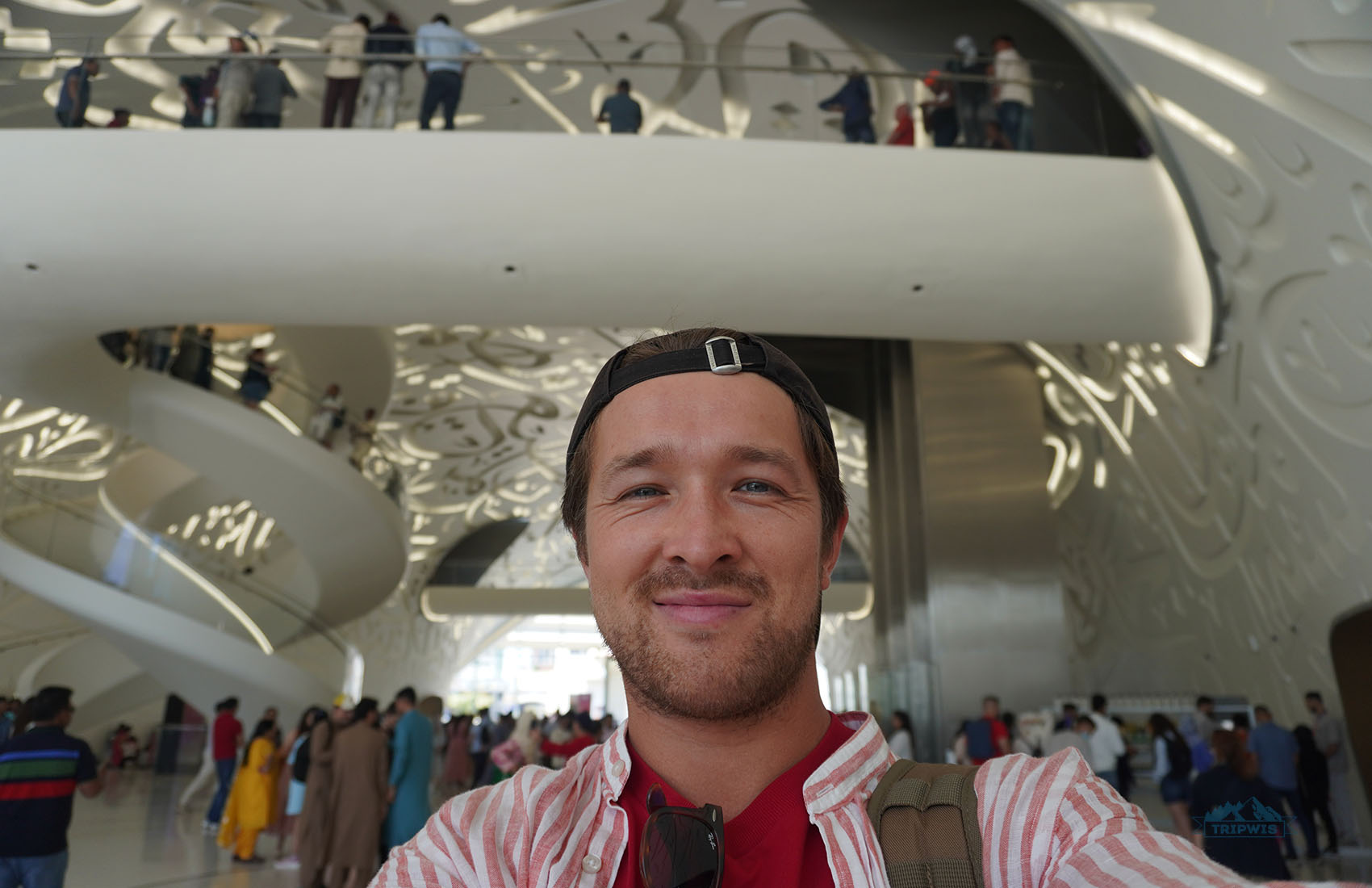
Museum of the Future timings, just like its tickets price breakdown, are simple and easy to remember: The museum is open every day, from 10 a.m. to 9:30 p.m.
Side note: The ticket counter closes earlier; its opening hours are from 10 a.m. to 7:30 p.m.
What are the exhibitions in the Museum of the Future?

Museum of the Future is a living museum, which means that its exhibitions gradually change over time. There are seven floors (or levels) total, but the layout has a little more nuance to it than a simple floor-by-floor sectioning. The collection of the Museum of the Future in Dubai is divided into four distinctive chapters.
Let’s take a closer look at what awaits you inside each chapter:

- Chapter 1: OSS Hope Station — your journey into the future starts right as your group is called to the elevator (pardon us, the space ship), and all the other easily impressed oohing and aahing visitors of the museum take out their phones to document the set off into the space.
Pro tip: As you enter the “cabin,” try and wiggle into the spot by the “window.” That way you’ll have front-row seats to witness your space ship fly through the Earth’s Stratosphere after a pretty impressive countdown, paired with the almost 4D experience of the cabin trembling, as if it’s a real take-off.
As you leave the Earth, you’ll get to see what Dubai is imagined to look like in the year 2071. Oh yeah, we forgot to mention, everything you see in this chapter is what the Museum of the Future’s curators picture space exploration to be like 50 years from now.
As you reach the OSS Hope Station (level 5 of the museum), “located almost 600 km above the Earth,” you’re welcomed into the station’s command center. Here you can learn all the scientific breakthroughs that will have plausibly already happened by that time (well, hopefully); like the way humans turned the Moon into a source of renewable energy, or the systems they created for future pioneers to successfully inhabit the station, looking at the Earth from afar…
The highlights: Floating replica of OSS Hope Station, interactive model of our solar system (bring Pluto back!), and the overall design of the walls — sleek, futuristic, and dimly lit to just the right degree to make you think you’re really in space. Plus, the opportunity to digitally apply to be the station’s pioneer and have your duties decided for you: You can get a role of an engineer, a pilot, or something else entirely.

- Chapter 2: The Heal Institute — it’s time to return back to Earth (or to the fourth level of the museum) and look at the state of the matters down there in the year 2071. Learn all about the Amazon and its spectacularly diverse ecological system through an interactive replica of a rainforest, filled with colorful and ever-evolving plants and creatures. The environment you get to witness in this installation is both real and magical-leaning. We were waiting for Tinkerbell to show her face from behind one of the giant leaves and sprinkle fairy dust all over the visitors (we promise, no illegal substances were consumed prior to our museum visit, we just often fall victims to childlike wonder and raging imagination).
Pro tip: Save space in your camera roll for the next installation of the chapter — The Library of Life — as it’s one of the most photographed areas in the museum. What does it look like? Imagine a giant dark room with rows and rows of floating colorful capsules, each containing a small avatar that represents one of the hundreds (2400, to be exact) of specimen that inhabit the Earth (and some that went extinct). This area is sometimes referred to as the DNA lab, and it’s supposed to remind humans of the interconnectedness of their life with other species. So, besides snapping a few cool-looking pics, take a second to let that thought sink in!

The next part of the chapter, the Heal Observatory (where some species are grown in “nurseries”) is more academic-centered, but still wildly fascinating. It inspires the visitors to go out into the real world with a new appreciation of our ecosystem and drive to save as much of it as we, as a species, possibly can.
The highlights: The shadow wall as you enter the chapter, it’s like trees and plants are really there, on the other side of this slightly see-through barrier, swaying in the wind. Moody lighting and assortment of shadows are definitely a design inspo for people decorating their homes (we know that we saved a few details in our minds for future reference).

- Chapter 3: Al Waha — after getting absolutely bombarded with messages of the future that awaits us as a species, chill out in the “sanctuary of the senses,” which is located on the third level of the museum. Much like going outside and touching grass in our present day, what the generations to come practice has the same idea in mind: Disconnecting from technology and reconnecting with your body, mind, and spirit. Ironically, this reconnection is built entirely through technological means; but aside from that, the whole area has truly the chillest vibes out of the whole museum (no wonder, since its name literally translates to “The Oasis” from Arabic). The design of the level is very womb-like, adding to the overall feeling of relaxation and safety.
Pro tip: Make use of the lounging chairs that surround the structure with water on top: It’s one of the best spaces for meditation we’ve ever encountered! Plus, don’t forget to make a wish before you leave Al Waha: Write your dream on a piece of paper and throw it into a special opening in the wall. They say it increases the chances of your wishes coming to life by tenfold!
The installations here are something else entirely. They use sound, light, water, and technology to bring you closer to your Zen state. Pop into a feeling therapy booth where they claim you can resensitize your hands and get a fresh heap of restorative energy. While the sensations are definitely weird and exciting, we wish that these small holes in the wall (literally) were a little bit more private, since it’s hard to reconnect with your senses when you have curious onlookers gazing over your shoulder.
The highlights: Vapor-like substance coming out of a water fountain-esque structure with a pleasing scent of essential oils by the entrance (try to refrain from doing vape tricks here, we know it’s tempting); plus the floor that projects sand-like movement onto the surface — the best part of it being you who controls the trajectory of the moving substance with your body motion.

- Chapter 4: Tomorrow Today — located on level 2, it’s one of the more flexible exhibitions of the Museum of the Future. Constantly on the pulse of the latest tech innovations, the museum’s curators pounce like tigers on the coolest flying car prototypes and jet-pack contraptions, among other modern discoveries.
Pro tip: Don’t spend too much time in front of the popular cyberdog; while being a pretty outstanding technological breakthrough, it’s not that same dog (created by Boston Dynamics) that you see all over the internet. Also, don’t forget to look up from time to time: You are guaranteed to be impressed by a giant agricultural drone that looks like a UFO prototype (can you imagine packing that thing up? And you thought your Maverick was a pain in the butt).
For tech geeks, every piece of the exhibit is deeply enthralling. The best part is, some of the newest tech isn’t far off into the future, as you could actually see the jet pack prototype being used in Dubai in 2022. Plus, as AI has gotten more and more recognition in recent months (with the museum “hiring” its first humanoid robot staff member a few months ago), we feel that the majority of gadgets that are on display in this chapter will find their way in our day-to-day lives in no time. Thankfully, scientific and technological progress never stops, so there will always be new gismos to take place at the Tomorrow Today exhibition.
The highlights: Hands down, the Uncanny Valley-looking robot, and all the sleek and modern cars.
As you might’ve guessed by now, there’s no one answer to the question of what is shown in Museum of the Future in Dubai: Every piece is inherently different and alludes to widely polarizing parts of science. Still, one thing we can say for sure — there are no references to the past, each exhibition is steadfastly focused on the future and ways we, as a society, can shape it to our advantage.
The constantly evolving chapters are the bulk of the current exhibitions in Museum of the Future in Dubai. But the curators don’t stop there: They are constantly putting out workshops, lectures, masterclasses, and talks in hopes of reaching an even wider audience.
- It’s easy to get lost in the myriad of events happening at the Museum of the Future every month, so we suggest simply following the museum on Instagram, where their program is neatly organized in their story highlights. So, if you missed Idris and Sabrina Elba taking part in a sustainable development conversation, or Deepak Chopra doing a meditation session inside the museum, next time you’ll be the first to know the new sought-after headliner!
What not to miss in the Museum of the Future?

You might wonder, what else can the museum possibly surprise me with? In short, all the details and hidden spaces you might’ve missed while being absolutely enthralled by the previously described chapters.
In our opinion, the following spaces cannot be missed, under any circumstances:
- Lobby — most museums can’t brag about their entrance spaces alluding to the themes of the exhibitions to come, but Museum of the Future in Dubai can. A giant space which you can enter even without a ticket, you can take in the interior rendition of the calligraphic writings on the building’s exterior. The lobby is large, airy, spacious, and filled with tons of cool things: You can witness a flying penguin and a jellyfish, a cute robodog that is actually moving, unlike its long-lost sister in the Tomorrow Today chapter. Also there’s a whimsical staircase that resembles a DNA model (at least one leg of the staircase should’ve been a slide, in our opinion, but alas), and an algorithmic perfumery stand, where you can make your own scent and get it packaged right there and then, leaving you with a highly personalized souvenir to remember the visit by.
- Viewing deck — located on the same level as Chapter 4 of the museum (Tomorrow Today), the viewing platform is set smack dab in the center of the Museum’s structural “hole.” It means that you don’t get the 360 views of Dubai per se, but something even better: An ability to take a closer look at the iconic museum construction, which is seemingly closing down on you from above, leaving two open sides to enjoy city views. And let us tell you, these spectacles alone are worth the entry ticket price!
- Future Heroes — the only explicitly children’s area located on the first level of the Museum of the Future in Dubai, it’s where the “future heroes” learn the important skills in a fun, playful manner. Designed for children under the age of 10, there are games, missions, and tasks meant to exercise the kids’ problem-solving abilities. Bring your kids here and relax, even if for a little while. We know museum outings can be exhausting both physically and mentally!
- Level Seven — a ginormous open space right under the intricately carved roof of the museum, mainly booked for important events. Plenty of YouTubers rent out this level just for the sake of getting close-up pictures and videos of the walls with no other tourists in the frame. And it is absolutely worth it: Here you can actually make out supporting beams that are hidden in the carved out window-esque openings, which is super exciting, since the museum’s building has zero (!) columns. Well, this is pretty much it when it comes to the floor planning; and no, we’re not forgetting about Level Six, as it’s reserved only for the Royals and not open to the average visitor.
- Gift shop — an experience in and of itself, visiting the gift shop is one of the things to do in Museum of the Future in Dubai that should not be disregarded as not adventurous or exciting. Truth is, apart from the usual stationery and little trinkets, the store carries tons of cool gismos and other unique (and obviously highly expensive) memorabilia, like EVSCOPE II Telescope (goes for “humble” 17 900 AED / $4875) or a sculpture by a Nottingham-based ceramicist Ally Powell that was inspired by the museum’s calligraphy (2900 AED / $790). Thankfully, the majority of items in the store is much more affordable: We found the Museum-inspired paperclips (39 AED / $11) particularly endearing!
On one side, there’s the view of the Sheikh Zayed Road with the ultra modern metro tracks running alongside it; on the other, the two giant Jumeirah Emirates Towers, looming over the museum as a couple of imposing yet fatherly (or motherly?) apostles.

Things to do near the Museum of the Future in Dubai
 |
 |
Now that you’ve got your fair share of both experiences and souvenirs, it’s time to explore other tourist attractions one might head to after paying a visit to the Museum of the Future in Dubai. That is, of course, if you still have some fuel in the tank (we know we were on the brink of falling asleep standing up from the pure overwhelm of emotions).
Here’s our list of places worth visiting in the general (by Dubai’s standards) museum area that you can also visit the next day, depending on how much time you have in the city:
- Dubai Frame — again, when it comes to the city’s layout, this tourist attraction is considered to be pretty close to the Museum of the Future.
Side note: In reality, it will take you at least an hour of walking to get from one point to another, but not because the distance is arguably long. It will take you around 10 minutes, tops, to cover the stretch of the road by car. This goes to show that Dubai isn’t a very pedestrian-friendly city, as giant overpasses require pedestrians to walk around in circles when the car finds a straight path right away.
Back to the Dubai Frame: It’s a spectacular monument (that serves as both an observatory and a museum) which is worth a visit even if you only have a limited time in the city. The shiny gold exterior glistens in the sun, attracting thousands of tourists each day.
The highlights: Medina-like exhibit showcasing the past of the emirate; views of both Old and New Dubai from the top of the frame (located 150 meters up), a glass part of the floor to test your fear of heights, and finally a video installation showcasing Dubai of the future (but you already know what it will look like, since you’ve just been to the Museum of the Future).
Price: 50 AED ($13.6) for the adult ticket (20 AED / $5.5 for kids). We advise you come here early in the morning to avoid crowds and long lines to the elevator. The attraction can also be experienced as part of a tour, like this one.
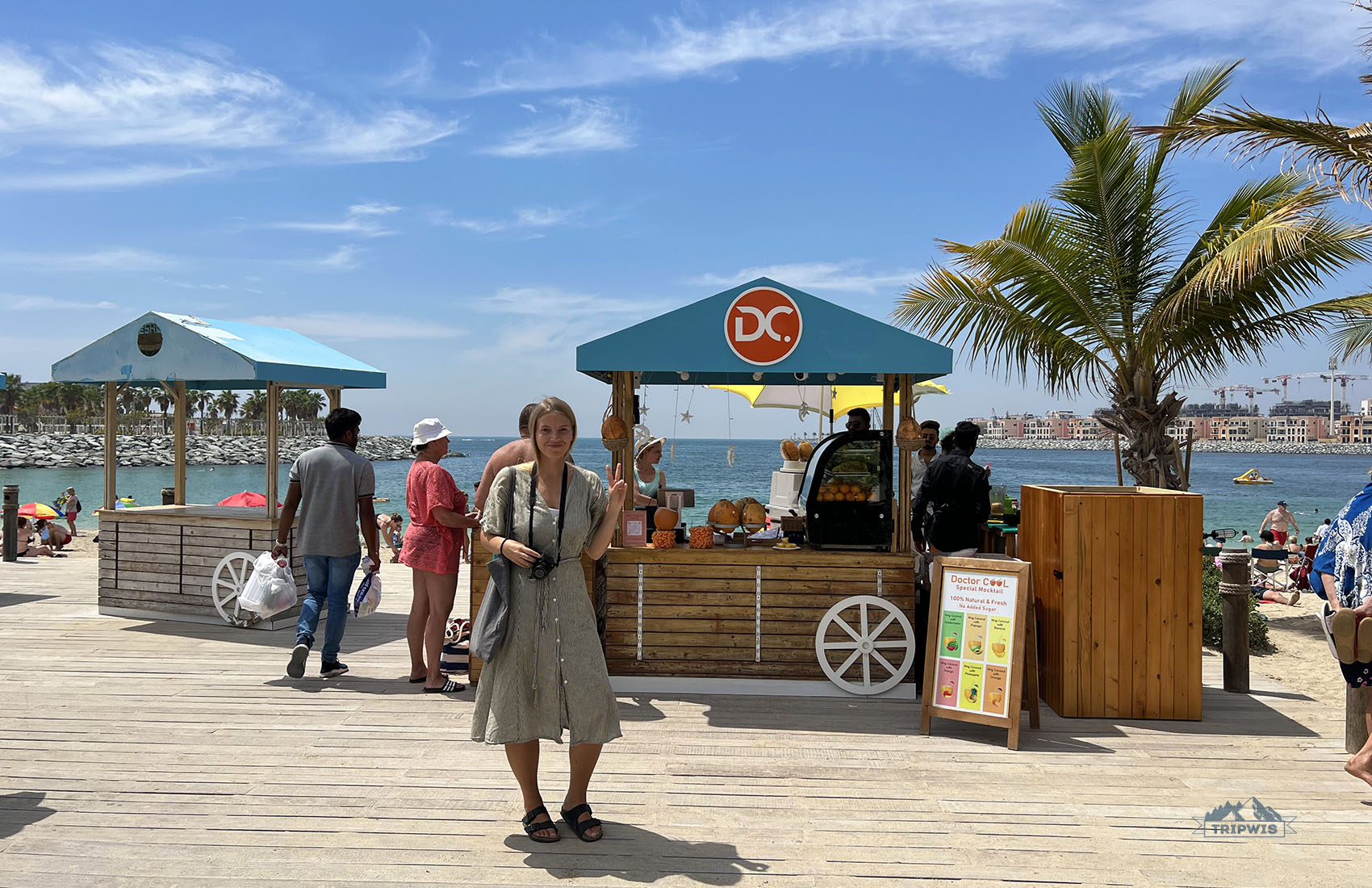
- La Mer Jumeirah Area — a sprawling beachfront shopping and dining district located in Jumeirah 1. The area has anything and everything: Dozens of restaurants and cafes, stores, as well as a trampoline and skateboard park, a cinema, and 2.5 kilometers long stretch of a beautiful beach (one of the best in the whole Dubai, actually). There are plenty of both kids and adult entertainment options, and the district bursts with colorful lights at night.
The highlights: The European-style part of the area with cobblestone streets and quaint outdoor dining options — you can feel like you’re on a movie set, and definitely not in Dubai. Plus, the staggering amount of street art: Graffiti here is off-the-charts spectacular, with walls of the buildings looking like a gallery of modern art around every corner you turn.
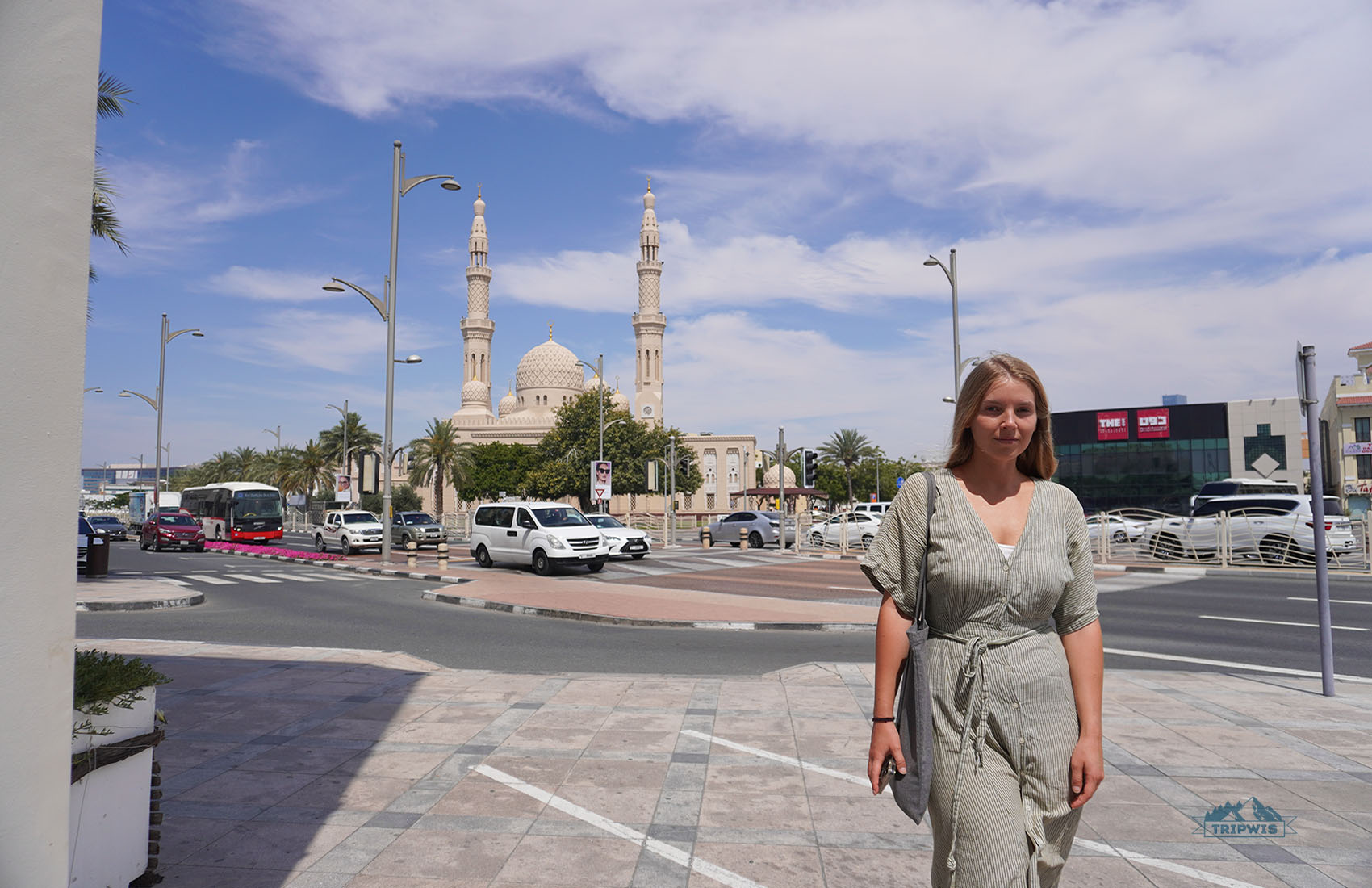
- Jumeirah Mosque — one of the rare instances when a mosque is open for people of all faiths and religious backgrounds. Constructed entirely out of white stone, with intricate gold detailing, the mosque is a thing of beauty. If you want to learn more about Islam and the overall Muslim traditions and rituals, there are guided tours here that happen every day except Friday, as part of the mosque’s Open Doors, Open Minds policy. Don’t be scared to ask questions, as it is a safe space for your curiosity to run free.
The highlights: Green carpeted interior of the mosque, lit up by ornate stained glass windows; the neatly kept mosque premises, and the promise of learning something new in a stress-free environment.
The guided tour costs 25 AED ($6.8) per person. No prior booking is necessary, you can purchase a ticket on site. It comes with complimentary refreshments of Arabic coffee or tea, as well as traditional sweet treats. Remember that Jumeirah Mosque is a working place of worship, so dress modestly (this concerns both men and women), and bring a head covering (this part is for ladies-only).
Important information
Now that you’ve probably figured out your itinerary that includes a visit to the Museum of the Future in Dubai, as well as other must-see tourist attractions of the emirate that are close to it, it’s time to handle the boring details of your visit: For example, how does one actually get to the Museum of the Future?
How to get to the Museum of the Future in Dubai?
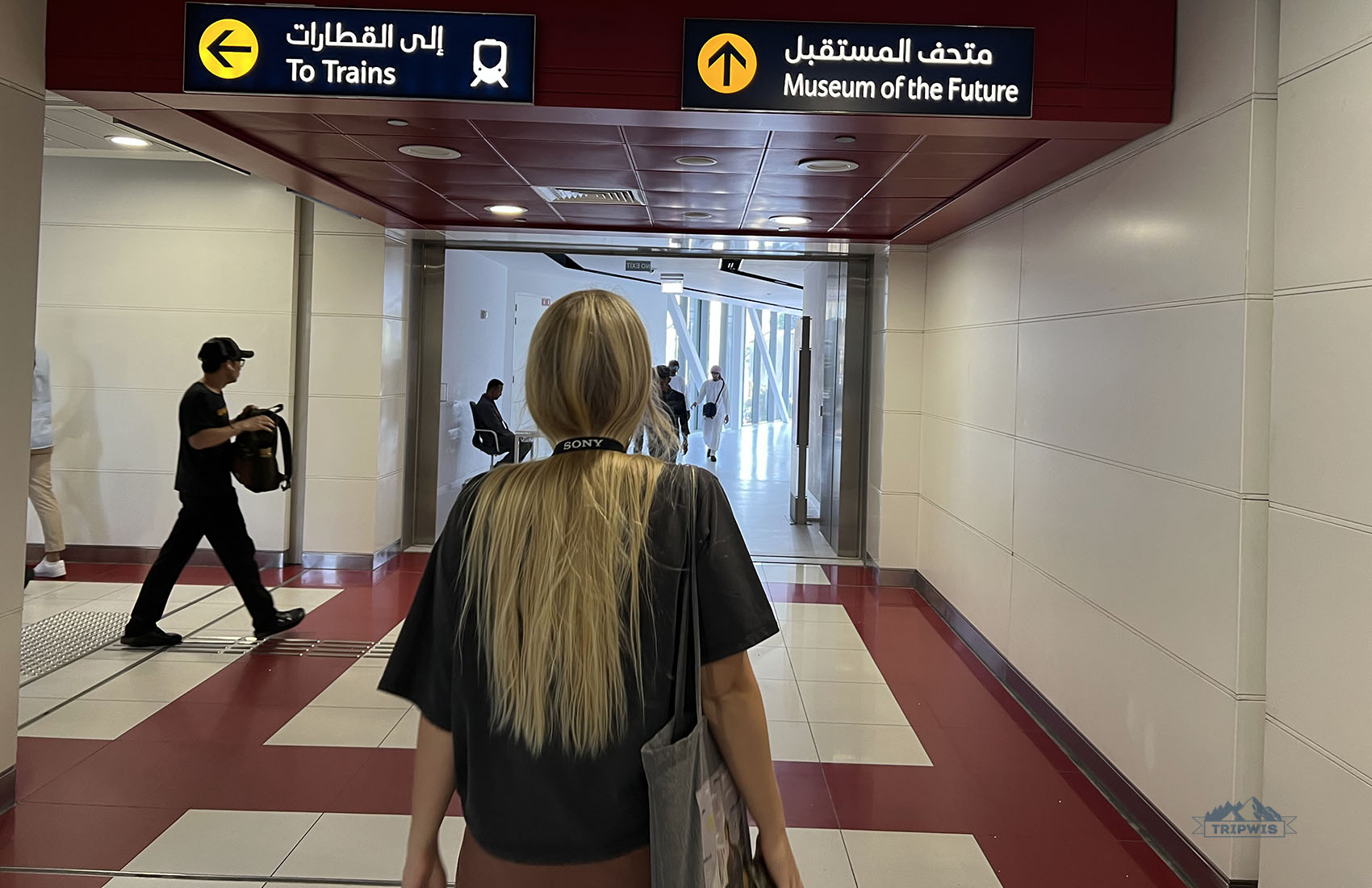
Museum of the Future is pretty easy to find: Get on any public transport that stops by the Emirates Towers (or use them to navigate your way when walking). Keep reading for a more detailed guide!
Personally, when it came to actually getting to the Museum of the Future, we opted for a taxi ride. It took us 25 minutes to get to the destination from the Burj Al Arab area and cost 35 AED ($9.5).
Pro tip: While Uber and local taxi app called Careem do operate in Dubai, we prefer to simply hail a cab in the street (so 90s of us, we know), since this way, the ride will be much cheaper than ordering through an app.
Dubai has the most advanced metro system in the entire world, so it would be a shame not to use it at least once. If you’re looking at a taxi fee that clearly exceeds your financial capabilities, take a chance on Dubai metro! The layout is pretty easy to understand, and the overall experience is a pleasant one. Thankfully, the Emirates Towers Metro Station (Red Line) is located not too far from the museum, a brisk walk over the link bridge will get you to the entrance in no time!
You can also choose to use the Dubai bus service network; the following lines stop not too far from your destination: 27, 29, X22 (get off at the Emirates Towers stop).
If you’ve rented a car to get around the city (probably even through our favorite car renting service LocalRent, wink wink), just put in the Museum of the Future address into your GPS:
67CP+H4Q – Sheikh Zayed Rd – Trade Centre – Trade Centre 2 – Dubai – United Arab Emirates.
All in all, if you’re a visual person, consult with our map, where we’ve pinned the exact location of the Museum of the Future, as well as three other attractions we’ve mentioned above.
Which museums in Dubai and Abu Dhabi do we recommend?
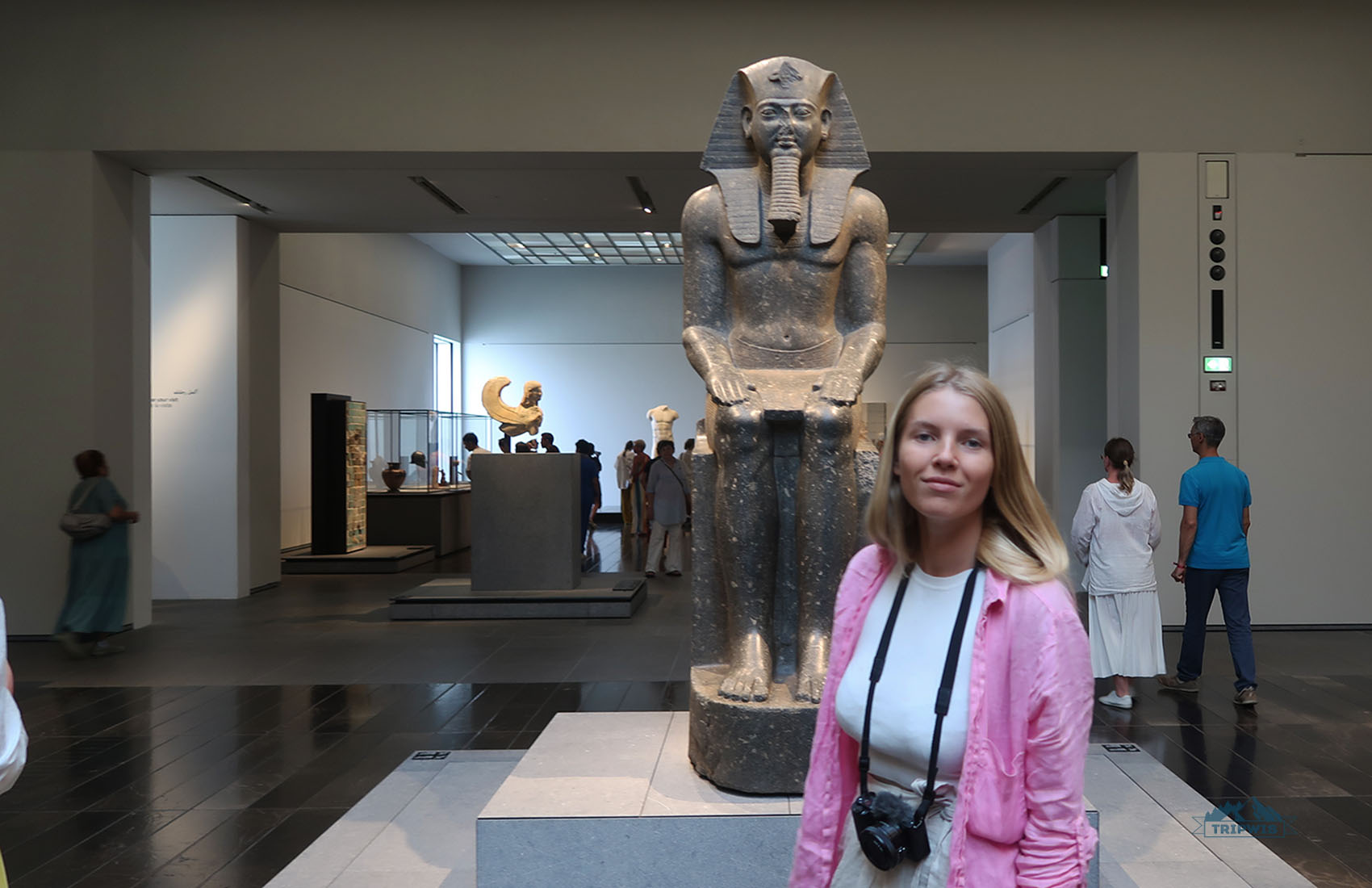
As much as we avoid going to museums in any new place we visit (not for the lack of interest, but for the stigma saying that all museums are dusty, stuffy, and severely outdated), going to these archives of history in Dubai and adjacent emirates was a surprisingly pleasant experience!
The UAE might have made us into museum and gallery-goers (enthusiasts might be a bit of a stretch, at least for now), after all! So, apart from the famed and fabled Museum of the Future, what are some other museums you should check out while in the Emirates?
- Louvre, Abu Dhabi — iconic both structurally and in terms of art pieces on display, Louvre museum in Abu Dhabi is a place to be if you know a thing or two about art and art history. How is the permanent collection of Louvre Abu Dhabi different from the O.G. Louvre, Paris? Well, here, in the UAE, the collection is arranged in chronological order, so that by walking through the galleries, you get the most all-encompassing art experience (in the original Louvre, the galleries are organized by a theme, so you can pick and choose the ones that most speak to you).
Entry fee is 63 AED ($17.2) per person. - Al Shindagha Museum, Dubai — this museum is most reminiscent of Dubai’s past; in fact, it’s the place that provided us with most of the information about how a small fishing village came to be a sprawling megapolis of the future. Come here for a chill atmosphere and a myriad of multimedia interactive experiences!
Entry fee is 50 AED ($13.6) per adult. - Alserkal Avenue, Dubai — a unique attraction set in a former industrial complex in the center of Dubai. The area is pretty hard to define: There are lots of small ultra-modern galleries, gutsy design spaces, cafes, pop-ups, and other contemporary creative businesses co-existing higgledy-piggledy (in a good way) with each other under one big roof. A hipster’s paradise, there’s always something new and exciting happening within the premises.
Entry to Alserkal Avenue is free unless stated otherwise: Masterclasses, workshops, and other events might require you to purchase a ticket. - Dubai Design District — also known as d3, it’s one of the newest (and coolest) neighborhoods of the emirate. It’s the design and fashion hub of the city, that, much as Alserkal Avenue, calls for creative souls from all over the world. Here, both well-established brands and young and naïve start-up visionaries share the space among sleek, modern-looking buildings, creating a sense of inspired and inspiring community. The district faces the water, and the promenade is often filled with creative art installations. Walk around, grab a drink or a bite, and exercise your visual senses in the process.
Entry to Dubai Design District is free.
We hope that our guide and review of the Museum of the Future in Dubai encouraged you to go out there and see what the future (duh) has to hold. It’s exciting to know that the next time you will see the Tomorrow Today chapter of the museum in a few years from now, it will be completely different. Museum of the Future is not a one-time affair, it’s the place you will want to come back time and time again. If you have any questions surrounding the details of your potential visit, leave them in the comments down below!
As for more down-to-earth things to know about Dubai, check out our recent posts on:
— The best time to visit the UAE: From the scorching sun of the summer to the mild winter days
— How much are you going to spend in one of the most extravagant cities in the world?
